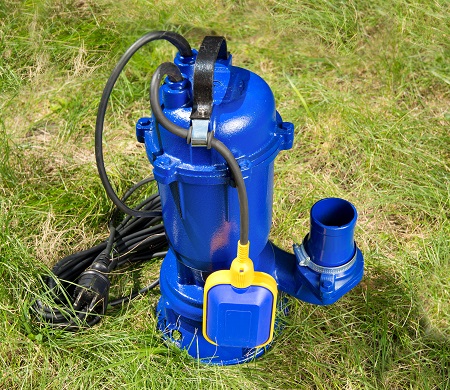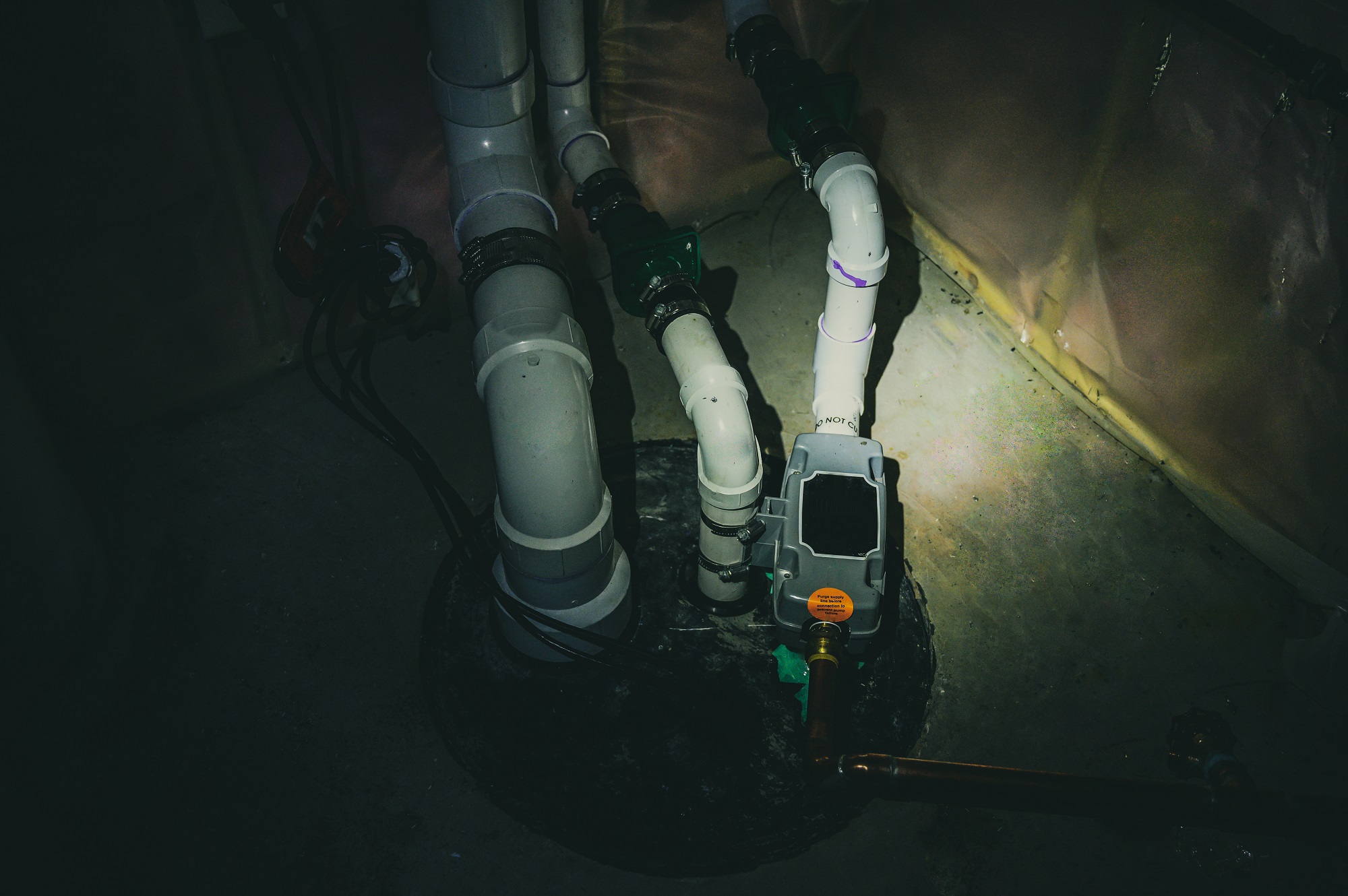When dealing with water in your basement, you’ve got two main options for sump pumps: pedestal and submersible.
Understanding the difference is key to choosing the right one for your needs.
Submersible sump pumps are designed to function underwater, directly in your sump pit. They’re quiet, efficient, and long-lasting but can be costlier upfront.
On the other hand, pedestal sump pumps aren’t meant to get wet; they sit above your pit with a hose that reaches down into the water. While noisier and less aesthetically pleasing, they’re usually more affordable and easier to maintain.
Each has its pros and cons depending on factors like cost considerations, maintenance ease, noise levels, and space constraints within your basement or crawlspace.
Let’s dive deeper into these two types of sump pumps so you can make an informed decision for protecting your home from potential water damage.
What Are Submersible Sump Pumps?

Ever wondered what submersible sump pumps are? These are specialized plumbing tools designed to prevent flooding in your basement.
They’re essential components of any effective water management system. A submersible sump pump is installed inside your sump pit – that’s the lowest section of your basement or crawl space. It’s fully encased in a waterproof housing since it’s made to operate underwater.
When the water level in your pit rises beyond a certain point, this handy device kicks into gear and pumps the excess water away from your home. The power of these pumps varies depending on their size and design. Some can shift thousands of gallons per hour – pretty impressive, right? Plus, they’re generally quieter than pedestal types because all those noisy parts are submerged.
When selecting a submersible pump for your property, consider factors such as power capacity, durability, and whether it has an automatic switch-on feature when the water reaches a certain level. This will ensure that even if you’re not at home during heavy rains or floods, your pump has got you covered!
What Are the Pros of Submersible Sump Pumps?
You’ll appreciate the quiet operation of submersible models as they’re submerged in water, which muffles the noise. These pumps are designed to take a beating – built with durable materials that resist corrosion and rusting. That means they’re well-suited for long-term use, making them a reliable choice for your sump pit.
Consider some of the other advantages of submersible sump pumps:
- Powerful Pumping Capacity/High Horsepower
- Quieter or Less Noisy
- Greater efficiency: Their design allows them to push water vertically more effectively than pedestal models.
- High-volume pumping: Submersibles can handle larger volumes of water, proving useful during intense rainfalls or rapid snow melts.
- Improved Safety Features
- Sealed motor: The motor is sealed within the pump casing, reducing the risk of electrical short circuits.
- Reduced overheating: Because they remain underwater while operating, their likelihood of overheating is significantly lower compared to pedestal pumps.
The technical aspect aside, from a practical standpoint, you’ll find these pumps easier to conceal due to their compact size. They sit at the bottom of your sump basin without protruding outwards like pedestal types do. No need to worry about an eyesore in your basement with a submersible pump handling your needs!
What Are the Cons of Submersible Sump Pumps?
Despite their many advantages, it’s important to note some downsides to having these types of water removal systems installed in your home. One con you need to consider with submersible sump pumps is the cost. They’re typically more expensive than pedestal pumps as they have a more intricate design and advanced features. This also means that repair costs can be higher if something goes wrong.
The installation process for submersibles can be quite complex, requiring a high level of technical expertise and precision. It involves placing the pump inside a sump pit, with the top sealed securely. Any mistakes made during this process could potentially compromise its function or lifespan.
Another drawback concerns their durability. Although built robustly to withstand constant immersion in water, submersible pumps tend to have shorter lifespans than their pedestal counterparts due to continuous exposure to moisture and potential debris that may cause wear and tear.
Moreover, accessing these units for maintenance or repairs can be challenging since they’re located below ground level within the sump basin. Frequent checks aren’t practical, which might lead to neglecting much-needed upkeep until a problem arises– possibly leading to costly damages or failures when least expected.
What Are Pedestal Sump Pumps?
Unlike submersible pumps that are submerged in water, a pedestal pump is positioned above the sump basin. The motor is elevated on a ‘pedestal’, hence its name.
They’re easier to maintain as you don’t have to reach into the pit to service them; all parts are visible and accessible from above ground level.
However, they do come with limitations. Pedestal pumps are often noisier due to their exposure and can be less aesthetically pleasing if your basement doubles as living space. Also, they may not handle larger volumes of water as efficiently as submersible models.
One thing is clear: whether it’s a pedestal or submersible for you depends largely on your specific needs. If longevity and maintenance ease rank high on your list, a pedestal pump might be your perfect fit!
What Are the Pros of Pedestal Sump Pumps?
Considering a water removal system that’s durable and easy to maintain? Then, you might find the advantages of these elevated motor models quite appealing.
Pedestal sump pumps offer a number of benefits that can make them an ideal choice for your home. One standout feature of this type of pump is its longevity. Since pedestal pumps have their motor mounted above the sump pit, they’re less likely to get wet or be damaged by flooding. This design keeps the motor out of contact with water, extending its lifespan significantly compared to submersible variants.
Next up is maintenance ease. With the essential components exposed and not submerged in water, troubleshooting and repairs are simpler tasks. You don’t need to drain your sump pit or dive into cold, murky water just to check on your pump’s condition.
These units also provide excellent performance at a lower cost than submersible models. They can handle high volumes of water efficiently, keeping your basement dry during heavy rainfall without breaking the bank.
Pedestal sump pumps offer impressive durability, straightforward maintenance, and cost-effective operations – making them a practical choice for any homeowner concerned about effective basement waterproofing.
What Are the Cons of Pedestal Sump Pumps?
While you might be tempted by the durability and affordability of these elevated motor models, it’s also worth noting a few drawbacks that could influence your decision.
- Noise Level: Unlike submersible pumps, which are designed to operate underwater and therefore produce less noise, pedestal pumps can be quite loud when operating due to the exposed motor.
- Aesthetic Consideration: Given that the motor is mounted above the pit on a stand, it may not be the most visually appealing choice if your basement or crawl space doubles as a living area.
- Limited Capacity: Pedestal sump pumps are not designed to handle large volumes of water. Due to their design, these pumps may struggle to keep up with heavy rainfall or excessive water accumulation.
- Lack of Multi-Purpose Functionality: Most pedestal-style units are designed solely for water removal and lack added features like ejecting sewage or handling solids.
John’s Plumbing & Pumps Does Sump Pump Installation Services
A sump pump serves as a reliable safeguard, ensuring the prevention of significant complications, provided it operates efficiently. Nonetheless, its effectiveness is contingent upon the proper functioning of all its components. If you cannot recall the last time a plumber inspected your sump pump, it would be advantageous to engage the services of John’s Plumbing & Pumps, Inc., who specialize in sump pump installation and repairs on properties in Puyallup. Identifying potential issues now is far preferable to discovering them when it is too late.
Other plumbing services we provide:
- Plumbing Emergencies
- Plumbing Repair
- All Sump Pump Services
- Water Leak Detection Service
- Clogged Toilets
- Water Heater Replacement
- Sewer Line Repairs
- Water Treatment Systems
- And More
Contact us today for sump pump repair and installation services.

